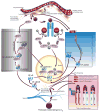Oxidative stress and cellular pathways of asthma and inflammation: Therapeutic strategies and pharmacological targets
- PMID: 28842273
- PMCID: PMC5743757
- DOI: 10.1016/j.pharmthera.2017.08.011
Oxidative stress and cellular pathways of asthma and inflammation: Therapeutic strategies and pharmacological targets
Abstract
Asthma is a complex inflammatory disease characterized by airway inflammation and hyperresponsiveness. The mechanisms associated with the development and progression of asthma have been widely studied in multiple populations and animal models, and these have revealed involvement of various cell types and activation of intracellular signaling pathways that result in activation of inflammatory genes. Significant contributions of Toll-like-receptors (TLRs) and transcription factors such as NF-кB, have been reported as major contributors to inflammatory pathways. These have also recently been associated with mechanisms of oxidative biology. This is of important clinical significance as the observed inefficacy of current available treatments for severe asthma is widely attributed to oxidative stress. Therefore, targeting oxidizing molecules in conjunction with inflammatory mediators and transcription factors may present a novel therapeutic strategy for asthma. In this review, we summarize TLRs and NF-кB pathways in the context of exacerbation of asthma pathogenesis and oxidative biology, and we discuss the potential use of polyphenolic flavonoid compounds, known to target these pathways and possess antioxidant activity, as potential therapeutic agents for asthma.
Keywords: Asthma; Inflammation; NF-кB; Oxidative stress; Polyphenolic flavonoid compounds; Toll-like receptors.
Copyright © 2017 Elsevier Inc. All rights reserved.
Conflict of interest statement
The authors have no conflict of interest to declare.
Figures


Similar articles
-
Fisetin-treatment alleviates airway inflammation through inhbition of MyD88/NF-κB signaling pathway.Int J Mol Med. 2018 Jul;42(1):208-218. doi: 10.3892/ijmm.2018.3582. Epub 2018 Mar 22. Int J Mol Med. 2018. PMID: 29568921 Free PMC article.
-
Flavonone treatment reverses airway inflammation and remodelling in an asthma murine model.Br J Pharmacol. 2013 Apr;168(7):1736-49. doi: 10.1111/bph.12062. Br J Pharmacol. 2013. PMID: 23170811 Free PMC article.
-
The role of endosomal toll-like receptors in asthma.Eur J Pharmacol. 2017 Aug 5;808:14-20. doi: 10.1016/j.ejphar.2016.09.033. Epub 2016 Sep 24. Eur J Pharmacol. 2017. PMID: 27677226 Review.
-
Toll-like receptors, cytokines and the immunotherapeutics of asthma.Curr Pharm Des. 2006;12(19):2365-74. doi: 10.2174/138161206777698918. Curr Pharm Des. 2006. PMID: 16842184 Review.
-
Gentisic acid ameliorates type 2 diabetes induced by Nicotinamide-Streptozotocin in male mice by attenuating pancreatic oxidative stress and inflammation through modulation of Nrf2 and NF-кB pathways.Life Sci. 2023 Jul 15;325:121770. doi: 10.1016/j.lfs.2023.121770. Epub 2023 May 14. Life Sci. 2023. PMID: 37192699
Cited by
-
Formononetin Attenuates Airway Inflammation and Oxidative Stress in Murine Allergic Asthma.Front Pharmacol. 2020 Sep 4;11:533841. doi: 10.3389/fphar.2020.533841. eCollection 2020. Front Pharmacol. 2020. PMID: 33013383 Free PMC article.
-
Saururus chinensis-controlled allergic pulmonary disease through NF-κB/COX-2 and PGE2 pathways.PeerJ. 2020 Sep 24;8:e10043. doi: 10.7717/peerj.10043. eCollection 2020. PeerJ. 2020. PMID: 33024647 Free PMC article.
-
Attenuating Effect of Peruvian Cocoa Populations on the Acute Asthmatic Response in Brown Norway Rats.Nutrients. 2020 Jul 31;12(8):2301. doi: 10.3390/nu12082301. Nutrients. 2020. PMID: 32751867 Free PMC article.
-
Oxidative Stress, Environmental Pollution, and Lifestyle as Determinants of Asthma in Children.Biology (Basel). 2023 Jan 13;12(1):133. doi: 10.3390/biology12010133. Biology (Basel). 2023. PMID: 36671825 Free PMC article. Review.
-
Dioscorea nipponica Makino Relieves Ovalbumin-Induced Asthma in Mice through Regulating RKIP-Mediated Raf-1/MEK/MAPK/ERK Signaling Pathway.Biomed Res Int. 2022 Jun 15;2022:8077058. doi: 10.1155/2022/8077058. eCollection 2022. Biomed Res Int. 2022. Retraction in: Biomed Res Int. 2024 Jan 9;2024:9840153. doi: 10.1155/2024/9840153. PMID: 35757465 Free PMC article. Retracted.
References
-
- Abel B, Thieblemont N, Quesniaux VJ, Brown N, Mpagi J, Miyake K, Bihl F, Ryffel B. Toll-like receptor 4 expression is required to control chronic Mycobacterium tuberculosis infection in mice. J Immunol. 2002;169:3155–3162. - PubMed
-
- Aderem A, Ulevitch RJ. Toll-like receptors in the induction of the innate immune response. Nature. 2000;406:782–787. - PubMed
-
- Akdis CA, Kussebi F, Pulendran B, Akdis M, Lauener RP, Schmidt-Weber CB, Klunker S, Isitmangil G, Hansjee N, Wynn TA, Dillon S, Erb P, Baschang G, Blaser K, Alkan SS. Inhibition of T helper 2-type responses, IgE production and eosinophilia by synthetic lipopeptides. Eur J Immunol. 2003;33:2717–2726. - PubMed
Publication types
MeSH terms
Substances
Grants and funding
LinkOut - more resources
Full Text Sources
Other Literature Sources
Medical

